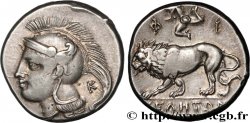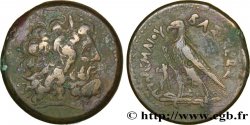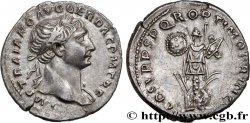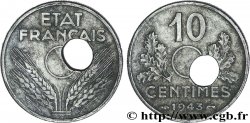v41_0027 - LUCANIA - VELIA Nomos, statère ou didrachme
MONNAIES 41 (2009)
Prezzo di inizio : 250.00 €
Valutazione : 380.00 €
Prezzo realizzato : 250.00 €
Prezzo di inizio : 250.00 €
Valutazione : 380.00 €
Prezzo realizzato : 250.00 €
Tipo : Nomos, statère ou didrachme
Data: c. 350/340 - 320/310 AC.
Nome della officina / città: Vélia
Metallo : argento
Diametro : 20 mm
Asse di coniazione : 3 h.
Peso : 7,29 g.
Grado di rarità : R1
Emission: groupe VI, section 62
Commenti sullo stato di conservazione:
Exemplaire sur un flan large et bien centré des deux côtés. Usure importante, mais parfaitement lisible et identifiable. Jolie patine gris foncé
N° nelle opere di riferimento :
Diritto
Titolatura diritto : ANÉPIGRAPHE ; MONOGRAMME DERRIÈRE LE CASQUE.
Descrittivo diritto : Tête d'Athéna à gauche, coiffée du casque phrygien à cimier avec triple aigrette, orné d'un centaure.
Legenda diritto : KE
Rovescio
Descrittivo rovescio : Lion passant à gauche, dévorant une proie.
Legenda rovescio : [U]ELHTW[N]/ A KE
Commento
De mêmes coins que les exemplaires de l’Ashmolean Museum d’Oxford (SNG Oxford, 1279 à 1281). La série 60 du classement de Williams se caractérise par un monogramme qui correspond à la signature du graveur Kléodoros. Sur cet exemplaire, on distingue très nettement un début de cassure de coin au droit devant le visage. Au revers, on remarque la présence de deux minuscules points devant l’antérieur et sous la queue. Très tôt, le monnayage de Vélia a été décrit comme ayant inspiré la drachme lourde de Marseille (LT. 785-791). Certains l’ont même décrit comme un monnayage symmachique : un lion de Vélia étant l’équivalent de deux lions de Marseille. Aujourd’hui, cette théorie est remise en cause.
Same dies as the examples in the Ashmolean Museum in Oxford (SNG Oxford, 1279 to 1281). Series 60 of the Williams classification is characterized by a monogram that corresponds to the signature of the engraver Kleodoros. On this example, we can clearly see the beginnings of a die break on the obverse in front of the face. On the reverse, we note the presence of two tiny dots in front of the fore-end and under the tail. Very early on, the coinage of Velia was described as having inspired the heavy drachma of Marseille (LT. 785-791). Some have even described it as a symmachic coinage: one lion of Velia being the equivalent of two lions of Marseille. Today, this theory is being challenged
Same dies as the examples in the Ashmolean Museum in Oxford (SNG Oxford, 1279 to 1281). Series 60 of the Williams classification is characterized by a monogram that corresponds to the signature of the engraver Kleodoros. On this example, we can clearly see the beginnings of a die break on the obverse in front of the face. On the reverse, we note the presence of two tiny dots in front of the fore-end and under the tail. Very early on, the coinage of Velia was described as having inspired the heavy drachma of Marseille (LT. 785-791). Some have even described it as a symmachic coinage: one lion of Velia being the equivalent of two lions of Marseille. Today, this theory is being challenged








 Segnalare un errore
Segnalare un errore Stampate la pagina
Stampate la pagina Condividi mia selezione
Condividi mia selezione Fai una domanda
Fai una domanda Consegnare / vendere
Consegnare / vendere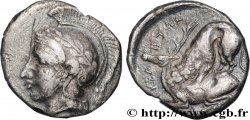
 Descrittivo
Descrittivo


